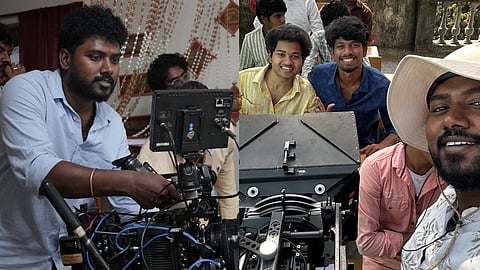

When a small-budget rom-com film like Little Hearts is playing to packed cinema halls as people roar in laughter, much of the credit often goes to the cast and the director. Yet, behind the camera, the technicians quietly shape every mood, every frame, and every captured emotion, and one of them is the director of photography. For Little Hearts, Suriya Balaji, a cinematographer who made his debut with the film, had a visual approach that gave the film its soft, disarmingly candid, and realistic tone.
In an exclusive conversation with CE, Suriya Balaji reflects on the unique challenge of grasping the rousing success of the film. “Marthand and I are still not able to believe it,” he says with a smile. He reflects on their surprise that even small town theatres like Srinivasa in Khammam were housefull, “It’s so satisfying to see people enjoying it.”
Little Hearts, directed by Sai Marthand and produced by Aditya Hasan under ETV Win Originals, follows Akhil (Mouli Tanuj), an intermediate underachiever, and Shivani Nagaram, caught in the relatable turmoil of student life and family dynamics. Unlike conventional Telugu commercial films, Little Hearts was envisioned somewhere in between realism and cinematic fiction. “It’s a complete dialogue-based movie. Marthand had this idea that it shouldn’t be a fully commercial Telugu film, nor completely raw reality. It should sit midway,” explains Suriya. Inspired by Malayalam films like Thanneer Mathan Dinangal, they pursued a hybrid of planned shooting with Alexa Mini and a guerrilla shooting approach, relying heavily on the Sony FX3 camera and minimal crew, for city montages in Hyderabad and Bengaluru.
“The shots in Indra Nagar, cityscapes, candid moments during the ‘Hello’ song, were all shot in a run-and-gun style, without permissions, just the camera and a gimbal. The Bengaluru shoot was like a trip, just a minimal crew and no lights. We even entered Numaish and shot just like an outing,” he shares. This spontaneity was deliberate, designed to capture the vibrancy of real life rather than constructed set pieces. “The whole idea was to create liveliness to show them in close-ups, in the moment. I just wanted to show the location restricted to them. No establishment shots, no waste of time. FX3 and Guerrilla filmmaking gave us life. If you look at the output, you won’t notice any difference. That was the challenge I took up as a DOP,” he adds.
Suriya fondly recalls his favourite moment, the Bengaluru opening shot. He says, “I made them walk on the road, and we just took the shots from a distance. There was something natural about that scene.” The decision to shoot mostly on overcast days wasn’t just technical, it was thematic. “We wanted that soft light feel throughout the film, to remain as true to the subjects as possible. I wanted to give it a slight glossy tone so I went with a Panchrome lens and Arri Alexa Mini, because we wanted that mobility,” he explains.
Starting after Sankranthi this year, Little Hearts’ production spanned around 27 working days, with an additional 5 days for guerrilla sequences. Suriya gives full credit to the collaborative atmosphere, “Marthand gave me complete freedom. Aditya Hasan was strict about keeping the film crisp but trusting us entirely.” Their goal, he explains, was ambitious, “Marthand and I believed the film shouldn’t look like a 2.4 crore production, but like a 10 crore one. People are calling us today and when they are hearing the budget, they are getting surprised.”
Looking ahead, Suriya is eager to grow. “I’m looking to level up now. I want to take on newer challenges,” he says. In today’s cinema often dominated by high-octane action or flashy visual effects, Little Hearts found its strength in humorous and light-hearted writing. And as Suriya Balaji subtly reminds us, great filmmaking isn’t about the budget, it’s about capturing life as it is, one candid moment at a time.